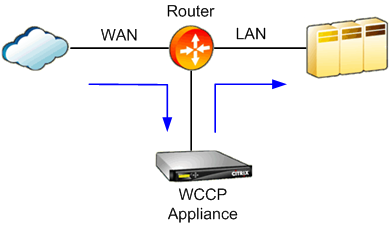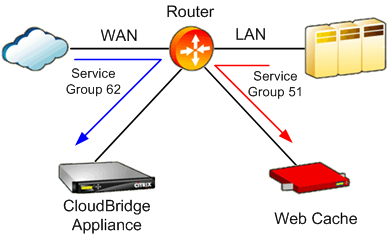WCCP Mode
Web Cache Communication Protocol (WCCP) is a dynamic routing protocol introduced by Cisco. Originally intended only for web caching, WCCP version 2 became a more general-purpose protocol, suitable for use by accelerators such as Citrix SD-WAN appliances.
WCCP mode is the simplest way of installing an SD-WAN appliance when inline operation is impractical. It is also useful where asymmetric routing occurs, that is, when packets from the same connection arrive over different WAN links. In WCCP mode, the routers use the WCCP 2.0 protocol to divert traffic through the appliance. Once received by the appliance, the traffic is treated by the acceleration engine and traffic shaper as if it were received in inline mode.
Note
For the purposes of this discussion, WCCP version 1 is considered obsolete and only WCCP version 2 is presented.
The standard WCCP documentation calls WCCP clients “caches.” To avoid confusion with actual caches, Citrix generally avoids calling a WCCP client a “cache.” Instead, WCCP clients are typically called “appliances.”
This discussion uses the term “router” to indicate WCCP-capable routers and WCCP-capable switches. Though the term “router” is used here, some high-end switches also support WCCP, and can be used with SD-WAN appliances.
The SD-WAN appliances support two WCCP modes:
WCCP is the original SD-WAN WCCP offering supported since release 3.x. It supports a single appliance service group (no clustering).
WCCP clustering, introduced in release 7.2, allows your router to load-balance traffic between multiple appliances.
How WCCP Mode Works
The physical mode for WCCP deployment of an SD-WAN appliance is one-arm mode in which the appliance is connected directly to a dedicated port on the WAN router. The WCCP standard includes a protocol negotiation in which the appliance registers itself with the router, and the two negotiate the use of features they support in common. Once this negotiation is successful, traffic is routed between the router and the appliance according to the WCCP router and redirection rules defined on the router.
A WCCP-mode appliance requires only a single Ethernet port. The appliance must either be deployed on a dedicated router port (or WCCP-capable switch port) or isolated from other traffic through a VLAN. Do not mix inline and WCCP modes.
The following figure shows how a router is configured to intercept traffic on selected interfaces and forward it to the WCCP-enabled appliance. Whenever the WCCP-enabled appliance is not available, the traffic is not intercepted, and is forwarded normally.
Figure 1. WCCP Traffic Flow

Traffic Encapsulation
WCCP allows traffic to be forwarded between the router and the appliance in either of the following modes:
- L2 Mode—Requires that the router and appliance be on the same L2 segment (typically an Ethernet segment). The IP packet is unmodified, and only the L2 addressing is altered to forward the packet. In many devices, L2 forwarding is performed at the hardware layer, giving it the maximum performance. Because of its performance advantage, L2 forwarding is the preferred mode, but not all WCCP-capable devices support it.
- GRE Mode—Generic Routing Encapsulation (GRE) is a routed protocol and the appliance can in theory be placed anywhere, but for performance it must be placed close to the router, on a fast, uncongested path that traverses as few switches and routers as possible. GRE is the original WCCP mode. A GRE header is created and the data packet is appended to it. The receiving device removes the GRE header. With encapsulation, the appliance can be on a subnet that is not directly attached to the router. However, both the encapsulation process and the subsequent routing add CPU overhead to the router, and the addition of the 28-byte GRE header can lead to packet fragmentation, which adds additional overhead.
WCCP mode supports multiple routers and both GRE vs. L2 forwarding. Each router can have multiple WAN links. Each link can have its own WCCP service group.
Traffic shaping is not effective unless the appliance manages UDP traffic as well as TCP traffic. A second service group, with a UDP service group for each WAN link, is recommended if traffic shaping is desired.
Registration and Status Updates
A WCCP client (an appliance) uses UDP port 2048 to register itself with the router and to negotiate which traffic must be sent to it, and also which WCCP features must be used for this traffic. The appliance operates on this traffic and forwards the resulting traffic to the original endpoint. The status of an appliance is tracked through the WCCP registration process and a heartbeat protocol. The appliance first contacts the router over the WCCP control channel (UDP port 2048), and the appliance and router exchange information with packets named “Here_I_Am” and “I_See_You,” respectively. By default, this process is repeated every 10 seconds. If the router fails to receive a message from the appliance for three of these intervals, it considers the appliance to have failed and stops forwarding traffic to it until contact is reestablished.
Services and Service Groups
Different appliances using the same router can provide different services. To keep track of which services are assigned to which appliances, the WCCP protocol uses a service group identifier, a one-byte integer. When an appliance registers itself with a router, it includes service group numbers as well.
- A single appliance can support more than one service group.
- A single router can support more than one service group.
- A single appliance can use the same service group with more than one router.
- A single router can use the same service group with more than one appliance. For SD-WAN appliances, multiple appliances are supported in WCCP cluster mode, and a single appliance is supported in WCCP mode.
- Each appliance specifies a “return type” (L2 or GRE) independently for each direction and each service group. SD-WAN 4000/5000 appliances always specify the same return type for both directions. Other SD-WAN appliances allow the return type to be different.
Figure 2. Using different WCCP service groups for different services

Multiple service groups can be used with WCCP on the same appliance. For example, the appliance can receive service-group 51 traffic from one WAN link and service-group 62 traffic from another WAN link. The appliance also supports multiple routers. It is indifferent to whether all the routers use the same service group or different routers use different service groups.
Service Group Tracking. If a packet arrives on one service group, output packets for the same connection are sent on the same service group. If packets arrive for the same connection on multiple service groups, output packets track the most recently seen service group for that connection.
High Availability Behavior
When WCCP is used with high-availability mode, the primary appliance sends its own apA or apB management IP address, not the virtual address of the high availability pair, when it contacts the router. If failover occurs, the new primary appliance contacts the router automatically, reestablishing the WCCP channel. In most cases the WCCP timeout period and the high availability failover time overlap. As a result, the network outage is less than the sum of the two delays.
Standard WCCP allows only a single appliance in a WCCP service group. If a new appliance attempts to contact the router, it discovers that the other appliance is handling the service group, and the new appliance sets an Alert. It periodically checks to determine whether the service group is still active with the other appliance, and the new appliance handles the service group when the other appliance becomes inactive. WCCP clustering allows multiple appliances per service group.
Deployment Topology
The following figure shows a simple WCCP deployment, suitable for either L2 or GRE. The traffic port (1/1) is connected directly to a dedicated router port (Gig 4/12).
Figure 3. Simple WCCP deployment

In this example, the SD-WAN 4000/5000 is deployed in one-arm mode, with the traffic port (1/1) and the management port (0/1) each connecting to its own dedicated router port.
On the router, WCCP is configured with identical IP wccp redirect in statements on the WAN and LAN ports. Two service groups are used, 71 and 72. Service group 71 is used for TCP traffic and service group 72 is used for UDP traffic. The appliance does not accelerate UDP traffic, but can apply traffic shaping policies to it.
Note: The WCCP specification does not allow protocols other than TCP and UDP to be forwarded, so protocols such as ICMP and GRE always bypass the appliance.
WCCP Clustering
SD-WAN appliances support WCCP clustering, which enables your router to load-balance your traffic between multiple appliances. For more information about deploying SD-WAN appliances as a cluster, see WCCP Clustering.
WCCP Specification
For more information about WCCP, see Web Cache Communication Protocol V2, Revision 1, http://tools.ietf.org/html/draft-mclaggan-wccp-v2rev1-00.
Note
When deploying SD-WAN in WCCP for switch redundancy, we can connect switch 2 to apB. Create a different SG for apB, give it a lower priority than the SG for apA. If apA higher SG is up, that will be used for redirection. If that is down, apB SG will be used. Note that apA and apB need to be on different subnet.